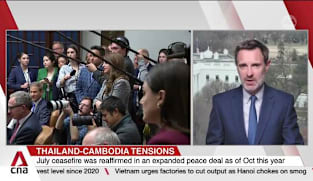Committee of Supply 2025 debate, Day 6: Ong Ye Kung on managing ‘trilemma’ of affordable, available and high-quality healthcare
Making public healthcare affordable, available and of high quality - these are the three big and competing objectives of the Ministry of Health (MOH), said Health Minister Ong Ye Kung. Speaking in parliament on Friday (Mar 7), he outlined the government’s strategies to achieve these objectives and manage this “trilemma”. The first objective is to secure financial affordability and sustainability by constantly reviewing and enhancing the "S+3Ms" framework of subsidies, MediSave, MediShield Life and MediFund. The government will double the MediSave withdrawal limit for outpatient scans to S$600, from S$300 per year, starting in 2026. The withdrawal limit for Flexi-MediSave will be raised to S$400 per year from the fourth quarter of this year. For dental health, the government will extend subsidies for selected procedures to CHAS Orange cardholders, as well as increase the CHAS dental subsidy limits for restorative procedures. It will also allow Flexi-MediSave to be used for costlier treatments at CHAS dental clinics and public healthcare institutions. For long-term care services for seniors, MOH will improve its subsidy framework with an entire package of enhancements that will benefit more than 80,000 seniors, up to S$2.1 billion from 2025 to 2030. The second objective is to ensure availability. From 2025 to 2030, the government plans to add 13,600 beds to its system, including about 2,800 public acute and community hospital beds for Singapore General Hospital, Changi General Hospital, Sengkang General Hospital and Woodlands Health. It will also include beds in the redeveloped Alexandra Hospital and Eastern General Hospital. This will bring public hospital beds to 15,000, from 12,000 in 2030 - an increase of 25 per cent. About 10,600 nursing home beds will be added. From 2030 to 2040, the new Tengah General Hospital will open, while the campuses of Singapore General Hospital and National University Hospital Kent Ridge would have undergone major redevelopment. The third and final objective is to ensure high quality in treating patients, leveraging innovative technologies and transforming the medical workforce. Stressing the need for Singaporeans to take ownership of their health, Mr Ong said a key to achieving these three competing objectives lies in a healthy population. “With better health, we can achieve all three at the same time, without trade-offs,” he said.
Making public healthcare affordable, available and of high quality - these are the three big and competing objectives of the Ministry of Health (MOH), said Health Minister Ong Ye Kung. Speaking in parliament on Friday (Mar 7), he outlined the government’s strategies to achieve these objectives and manage this “trilemma”. The first objective is to secure financial affordability and sustainability by constantly reviewing and enhancing the "S+3Ms" framework of subsidies, MediSave, MediShield Life and MediFund. The government will double the MediSave withdrawal limit for outpatient scans to S$600, from S$300 per year, starting in 2026. The withdrawal limit for Flexi-MediSave will be raised to S$400 per year from the fourth quarter of this year. For dental health, the government will extend subsidies for selected procedures to CHAS Orange cardholders, as well as increase the CHAS dental subsidy limits for restorative procedures. It will also allow Flexi-MediSave to be used for costlier treatments at CHAS dental clinics and public healthcare institutions. For long-term care services for seniors, MOH will improve its subsidy framework with an entire package of enhancements that will benefit more than 80,000 seniors, up to S$2.1 billion from 2025 to 2030. The second objective is to ensure availability. From 2025 to 2030, the government plans to add 13,600 beds to its system, including about 2,800 public acute and community hospital beds for Singapore General Hospital, Changi General Hospital, Sengkang General Hospital and Woodlands Health. It will also include beds in the redeveloped Alexandra Hospital and Eastern General Hospital. This will bring public hospital beds to 15,000, from 12,000 in 2030 - an increase of 25 per cent. About 10,600 nursing home beds will be added. From 2030 to 2040, the new Tengah General Hospital will open, while the campuses of Singapore General Hospital and National University Hospital Kent Ridge would have undergone major redevelopment. The third and final objective is to ensure high quality in treating patients, leveraging innovative technologies and transforming the medical workforce. Stressing the need for Singaporeans to take ownership of their health, Mr Ong said a key to achieving these three competing objectives lies in a healthy population. “With better health, we can achieve all three at the same time, without trade-offs,” he said.



















